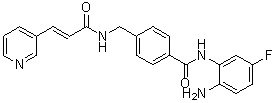Chidamide (Tucidinostat, HBI8000, CS 055)
This product is for research use only, not for human use. We do not sell to patients.

For small sizes, please check our retail website as below: www.invivochem.com
| Size | Price | Stock |
|---|---|---|
| 100mg | $1150 | To Be Confirmed |
| 250mg | $1850 | To Be Confirmed |
| 500mg | $2775 | To Be Confirmed |
Cat #: V3843 CAS #: 1616493-44-7 Purity ≥ 98%
Description: Chidamide (CS-055, Tucidinostat, HBI-8000; trade name: Epidaza), is a potent and orally bioavailable benzamide-type histone deacetylase (HDAC) inhibitor with IC50s of 95, 160, 67 and 78 nM for HDAC1, HDAC2, HDAC3 and HDAC10, respectively.
Top Publications Citing Invivochem Products
Publications Citing InvivoChem Products
Product Promise

- Physicochemical and Storage Information
- Protocol
- Related Biological Data
- Stock Solution Preparation
- Quality Control Documentation
| Molecular Weight (MW) | 390.41 |
|---|---|
| Molecular Formula | C22H19FN4O2 |
| CAS No. | 1616493-44-7 |
| Storage | -20℃ for 3 years in powder formr |
| -80℃ for 2 years in solvent | |
| Solubility In Vitro | DMSO: ≥ 41 mg/mLr |
| Water: < 1 mg/mLr | |
| Ethanol: < 1 mg/mL | |
| Synonyms | HBI8000; HBI 8000; HBI-8000; CS055; CS-055; CS 055; Chidamide; Tucidinostat |
| Protocol | In Vitro | Tucidinostat (Chidamide/CS055/HBI-8000) is a potent and orally bioavailable HDAC enzymes class I (HDAC1, 2, 3) and class IIb (HDAC10) inhibitor, with IC50s of 95, 160, 67 and 78 nM, less active on HDAC8 and HDAC11 (IC50s, 733 nM, 432 nM, respectively), and shows no effect on HDAC4/5/6/7/9 (IC50s, >30 μM). Tucidinostat shows potent antitumor activity, and inhibits several human derived tumor cell lines, such as HL-60, U2OS, LNCaP with GI50s of 0.4 ± 0.1, 2.0 ± 0.6, and 4.0 ± 1.2 μM, respectively. In addition, Tucidinostat shows less toxic to normal cells from human fetal kidney (CCC-HEK) and liver (CCCHEL). |
|---|---|---|
| In Vivo | Tucidinostat (12.5-50 mg/kg, p.o.) dose-dependently reduces tumor size and tumor weight in mice bearing HCT-8 colorectal carcinoma, A549 lung carcinoma, BEL-7402 liver carcinoma, and MCF-7 breast carcinoma, and with no obvious body loss |
These protocols are for reference only. InvivoChem does not
independently validate these methods.
| Solvent volume to be added | Mass (the weight of a compound) | |||
|---|---|---|---|---|
| Mother liquor concentration | 1mg | 5mg | 10mg | 20mg |
| 1mM | 2.5614 mL | 12.8070 mL | 25.6141 mL | 51.2282 mL |
| 5mM | 0.5123 mL | 2.5614 mL | 5.1228 mL | 10.2456 mL |
| 10mM | 0.2561 mL | 1.2807 mL | 2.5614 mL | 5.1228 mL |
| 20mM | 0.1281 mL | 0.6404 mL | 1.2807 mL | 2.5614 mL |
The molarity calculator equation
Mass(g) = Concentration(mol/L) × Volume(L) × Molecular Weight(g/mol)
Mass
=
Concentration
×
Volume
×
Molecular Weight*
The dilution calculator equation
Concentration(start)
×
Volume(start)
=
Concentration(final)
×
Volume(final)
This equation is commonly abbreviated as: C1 V1 = C2 V2
Concentration(start)
C1
×
Volume(start)
V1
=
Concentration(final)
C2
×
Volume(final)
V2
Step One: Enter information below
Dosage mg/kg
Average weight of animals g
Dosing volume per animal µL
Number of animals
Step Two: Enter the in vivo formulation
%DMSO
+
%
+
%Tween 80
+
%ddH2O
Calculation Results:
Working concentration:
mg/ml;
Method for preparing DMSO master liquid:
mg
drug pre-dissolved in
µL
DMSO(Master liquid concentration
mg/mL)
,Please contact us first if the concentration exceeds the DMSO solubility of the batch of drug.
Method for preparing in vivo formulation:
Take
µL
DMSO master liquid, next add
µL
PEG300, mix and clarify, next add
µL
Tween 80,mix and clarify, next add
µL
ddH2O,mix and clarify.
Note:
- (1) Please be sure that the solution is clear before the addition of next solvent. Dissolution methods like vortex, ultrasound or warming and heat may be used to aid dissolving.
- (2) Be sure to add the solvent(s) in order.




































